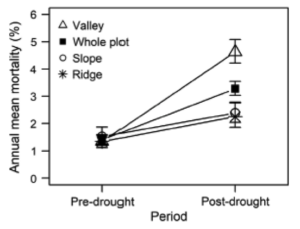Investigation of the effects of a severe ENSO-related drought on biomass dynamics in a lowland rainforest in the Amazon
The Science
Forest mortality controls the forest carbon cycle. Extreme climatic events in the Amazon are expected to become more frequent, resulting in increased forest mortality. However, the extent to which individual drought events affect biomass loss, and the resulting resilience of Amazonian forests to drought, are not well understood. These baseline observations are critical for testing models of drought effects on forest carbon fluxes at a pantropical scale.

The Impact
In this study, we tracked biomass dynamics in over 14,000 trees in 25 hectares of forest in the Colombian Amazon before and after an intense ENSO-related drought. Drought led to a significant reduction in forest biomass, with valley forests being more negatively affected than ridge forests. Surprisingly, however, the forest bounced back rapidly following the drought. Rapid biomass recovery suggests that these forests may be more resilient to periodic ENSO events than anticipated.
Summary
Since understanding drivers of tree mortality is essential for modeling forest biomass responses to changing climatic and environmental conditions, this work makes an important contribution to the NGEE-Tropics project. The results suggest a high degree of resilience of this Amazonian forest to drought. Enhanced performance of drought-tolerant species that inhabit the drier ridges enabled forest resilience. The diversity of species’ ecologies and physiologies may provide an important buffer for tropical forests during extreme climatic events. The results have important implications for understanding drought impacts elsewhere in the Amazon and in other tropical forest areas.
Contacts (BER PM): Daniel Stover, SC-23.1, Daniel.Stover@science.doe.gov (301-903- 0289)
PI Contact: Stuart Davies, ForestGEO-CTFS, Smithsonian Tropical Research Institute, daviess@si.edu
Funding
Funds for the tree censuses were in part provided by the Smithsonian Institution Center for Tropical Forest Science—Forest Global Earth Observatory (CTFS-ForestGEO). Additional funds came from the COLCIENCIAS funding program in Colombia for both plot census costs and a fellowship to DZ. SJD received support from the Next Generation Ecosystem Experiment (NGEE) Tropics project.
Publications
Zuleta, D., A. Duque, D. Cardenas, H. C. Muller-Landau, and S. J. Davies (2017), Drought-induced mortality patterns and rapid biomass recovery in a terra firme forest in the Colombian Amazon, Ecology, 98(10), 2538–2546, doi:10.1002/ecy.1950.